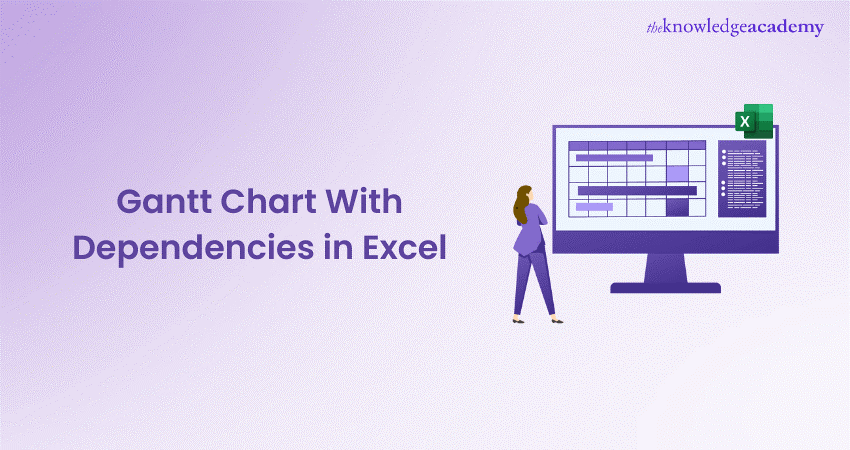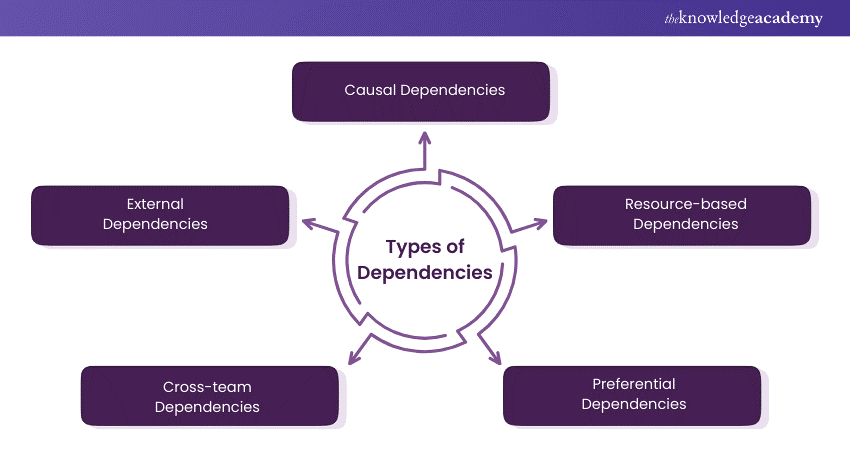We may not have the course you’re looking for. If you enquire or give us a call on 01344203999 and speak to our training experts, we may still be able to help with your training requirements.
Training Outcomes Within Your Budget!
We ensure quality, budget-alignment, and timely delivery by our expert instructors.

Are your projects derailed by overlapping tasks and unclear dependencies? Introducing Gantt Charts, a visual tool to create accurate schedules and manage complex tasks seamlessly and smoothly. In a recently conducted survey, traditional Gantt charts were identified as the most preferred project management tool, utilised by 36% of respondents, while other formats like task lists and kanban boards were used by 21% and 16%, respectively. In this blog, we shed spotlights on the Gantt Chart with dependencies in Excel, further exploring its advantages, types, and valuable tips to get along this performing-enhancing journey! Let’s step into the spotlight!
Table of Contents
1) What are Gantt Chart Dependencies in Excel?
2) How to add Dependencies in Gantt Excel?
3) Types of Dependencies
4) Advantages of employing Gantt Chart Dependencies
5) Tips for handling project Dependencies
6) Conclusion
What are Gantt Chart Dependencies in Excel?
Gantt Chart Dependencies serve as a framework that illustrates the relationships between project tasks. They outline the sequence in which activities must be performed, ensuring that one task cannot commence until its predecessor is finished. For project managers, grasping these relationships is vital for maintaining smooth workflows.
There are four primary types of dependencies typically utilised in Gantt Charts, each defining how one task connects to another concerning its start and endpoints. Understanding these types is essential for effective project planning and execution.
Advantages of Employing Gantt Chart Dependencies
A Gantt Chart with Dependencies in Excel serves as a powerful project management tool that visually represents project schedules, tasks, and interdependencies. Here are the key benefits of using Gantt Chart Dependencies:

1) Gain a Comprehensive Understanding of Interconnected Tasks
Gantt Chart Dependencies provide a clear perspective on how tasks are linked within a project. Project managers can easily analyse the sequence of work, identifying which tasks must be completed before others. This clarity helps visualise the workflow and can prevent potential bottlenecks.
2) Improve Resource Allocation
By utilising Gantt Chart Dependencies, project managers can enhance resource allocation. Understanding the specific requirements allows them to assign resources effectively, ensuring optimal utilisation by distributing them to the right team members.
3) Monitor Key Tasks
Dependencies in Gantt Charts allow project managers to focus on the most crucial tasks for project success. By identifying the interdependencies, they can monitor progress effectively and address any deviations from the plan, ensuring that essential tasks remain on track.
4) Simplify the Scheduling of Project Activities
Gantt Chart Dependencies streamline the process of adjusting project schedules. If a task's completion is delayed or expedited, the Gantt Chart automatically updates the dependent tasks. This dynamic feature saves time and effort compared to manual adjustments.
Elevate your proficiency with our Microsoft Excel Course – register today!
How to add Dependencies in Gantt Excel?
Adding Dependencies in Excel Gantt Charts comprises a series of steps, which are stated below:
1) Open Microsoft Excel and put your project tasks into a Gantt Chart. These tasks should be listed in a single column with the corresponding start and end dates in other columns.
2) Post that, assess the tasks that are dependent on others. For example, Task B cannot start until Task A finishes.
3) Add a new column to your Excel sheet specifically for Dependencies. This column should indicate which task each row is dependent on.
4) In the dependency column, utilise code to represent the Dependencies. Those codes can include Finish-to-Start (FS), Start-to-Start (SS) , Finish-to-Finish (FF), and Start-to-Finish (F).
5) Use colour coding or symbols to make the Dependencies in a visually appealing manner. You can also use arrows or specific colours to represent different types of Dependencies.
6) After adding the Dependencies, make sure your Gantt Chart shows these connections. Dependencies activities should be connected using arrows or other indicators.
Types of Dependencies
Dependencies in project management are critical elements that evaluate the flow and sequence of tasks. They outline the organisation of activities, including their starting and ending conditions. Below are the different types of dependencies often encountered:

1) Causal Dependencies
Causal dependencies are essential as they denote the logical sequence of tasks. In this case, Task B cannot commence until Task A is completed. For instance, in construction, pouring concrete (Task A) must occur before erecting the walls (Task B). This ensures that tasks progress logically and efficiently.
2) Resource-based Dependencies
Resource-based dependencies depend on the availability of necessary resources. Task B may not begin until the required resources from Task A are available. For example, if Task A requires a specific machine, Task B will have to wait until that machine is free. This type of dependency promotes efficient resource utilisation.
3) Preferential Dependencies
Preferential dependencies relate to project priorities. This occurs when one team's task is contingent on deliverables from another team. For instance, coding (Task B) might not commence until the design team receives results from the software development team (Task A). Effective coordination and communication are important for a smooth workflow and timely project completion.
4) Cross-team Dependencies
In larger projects involving multiple teams, cross-team dependencies come into play. These occur when one team's task relies on deliverables from another team. For example, the software development team (Task A) may need to wait for the design team's output (Task B) before starting coding. Such dependencies necessitate efficient coordination and communication between teams.
5) External Dependencies
External dependencies include factors outside the project team's direct control. These can involve waiting for regulatory approvals, vendor deliveries, or changes in market conditions. For example, a construction project (Task A) may need to wait for government permits (Task B) before it can begin. These dependencies underscore the importance of having contingency plans and proactively managing external factors that can affect project timelines.
Supercharge your Excel skills – join our Excel Training With Gantt Charts Course today!
Tips for Handling Project Dependencies
Managing project dependencies effectively is vital for ensuring timely and successful project completion. Here are some essential strategies to help you navigate this aspect smoothly:
1) Regularly Assess Dependencies: As your project evolves, dependencies can shift. It’s important to regularly assess and update them to keep your schedule accurate.
2) Utilise Dependency Tracking Tools: Consider leveraging project management software equipped with advanced dependency tracking capabilities. Tools like Microsoft Project and Asana can significantly enhance your dependency management process.
3) Ensure Clear Communication of Dependencies: Team members need to understand the dependencies related to their tasks. Establishing clear communication is crucial to avoid misunderstandings and prevent delays.
Conclusion
We hope you understand the Gantt Chart with Dependencies in Excel. It serves as a robust tool for Project Managers to perform their tasks effectively. Understanding the various Dependency types and learning about how to add them in Excel can significantly improve project planning and execution. Moreover, employing these Dependencies enhances resource allocation, monitors crucial tasks, and maintains efficient project schedules.
Boost your skills with our Microsoft Excel VBA And Micro Training - book your spot now!
Frequently Asked Questions

A Gantt chart visually illustrates the dependencies between tasks by showing how each task is linked to others. It highlights the sequence in which tasks must be completed, ensuring clarity in project timelines and workflows. This helps project managers optimise scheduling and resource allocation effectively.

Gantt chart milestones are key markers that signify important events or deadlines within a project timeline. They represent significant achievements, such as the completion of a phase or deliverable, helping project managers track progress and maintain focus on critical objectives. Milestones enhance accountability and facilitate effective project monitoring.

The Knowledge Academy takes global learning to new heights, offering over 30,000 online courses across 490+ locations in 220 countries. This expansive reach ensures accessibility and convenience for learners worldwide.
Alongside our diverse Online Course Catalogue, encompassing 19 major categories, we go the extra mile by providing a plethora of free educational Online Resources like News updates, Blogs, videos, webinars, and interview questions. Tailoring learning experiences further, professionals can maximise value with customisable Course Bundles of TKA.

The Knowledge Academy’s Knowledge Pass, a prepaid voucher, adds another layer of flexibility, allowing course bookings over a 12-month period. Join us on a journey where education knows no bounds.

The Knowledge Academy offers various Microsoft Excel Training & Certification Courses, including the Microsoft Excel Course, Excel Training with Gantt Charts, and Excel for Accounting Course. These courses cater to different skill levels, providing comprehensive insights into Excel Data Visualisation.
Our Office Applications Blogs cover a range of topics related to Microsoft Excel, offering valuable resources, best practices, and industry insights. Whether you are a beginner or looking to advance your Office Applications skills, The Knowledge Academy's diverse courses and informative blogs have got you covered.
Upcoming Office Applications Resources Batches & Dates
Date
 Excel Training with Gantt Charts
Excel Training with Gantt Charts
Fri 20th Dec 2024
Fri 14th Feb 2025
Fri 11th Apr 2025
Fri 13th Jun 2025
Fri 15th Aug 2025
Fri 10th Oct 2025
Fri 12th Dec 2025







 Top Rated Course
Top Rated Course



 If you wish to make any changes to your course, please
If you wish to make any changes to your course, please


